How Can You Cook Salmon in the Oven?
In order to learn how to cook salmon in the oven, we need to embrace the qualities of salmon. We will talk about salmons and how to cook salmon in the oven. Not everyone is adept at preparing fish. For those new to salmon, the full filet of baked salmon is a fantastic place to start because it offers an easy and healthy meal for just about any crowd.
Placing a large, gorgeous, coral-hued baked salmon filet in the middle of the table is a lovely modern variation on the traditional gathering of the group around a roast chicken, whether you’re preparing salmon for just the family or a large group of friends. Roasted salmon filets are one of the best main dishes you can make if you want something simple but elegant.
What Is Salmon?
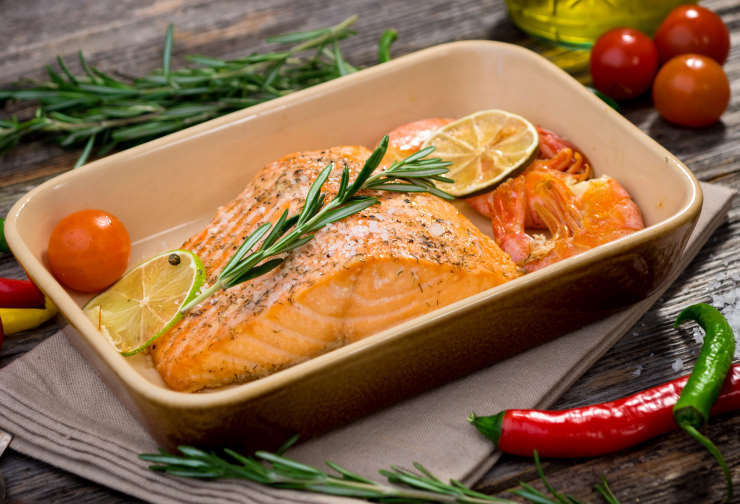
The common name for fish in the Salmonidae family is salmon. Trout, char, and whitefish are other members of the same family of fish. The tributaries of the North Atlantic and Pacific seas are home to salmon. Salmons are frequently referred to as anadromous since they leave freshwater after hatching and then return to it to spawn in the ocean. Folklore holds that the fish returns to the precise spot where it spawns.
The salmon is a long fish with two pairs of paired fins on the side and pelvis, four single fins around the body, and a pointed or hooked beak. The majority of the year, it seems to be a brilliant silver with pockets of blue, crimson, green, pink, or purple coloration, but when spawning season approaches, the scales take on a variety of vivid hues.
Additionally, certain species may alter physically, developing a hump, a bent jaw, or canine teeth. Salmon is one of the world’s healthiest foods. Depending on the type, salmon might have slightly different nutritional values. For instance, farmed salmon provides slightly more calories and healthy fats than wild-caught salmon, while wild-caught salmon has slightly more protein.
Salmon is a popular fish renowned for its high protein and omega-3 fatty acid content. Around the world, different civilizations enjoy salmon in a wide range of forms. The northern Atlantic and Pacific waters contain salmon.
Fun Facts About Salmon
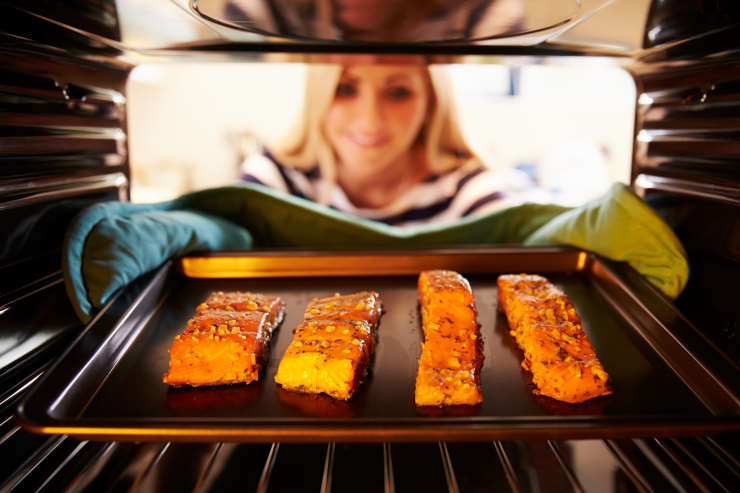
Salmon are classified as “anadromous” animals because they can live in both fresh and salt water. After birth, they migrate to the ocean for a few months to several years, depending on the species. When it’s time to spawn, they migrate back to freshwater. Few other fish can withstand such extreme salinity swings, and salmon would perish if they switched from salt to fresh water.
In freshwater streams, salmon are known to lay their eggs, usually at high latitudes. Alevin or sac fry is produced when the eggs hatch. Some species are restricted to freshwater, whereas others may exist in saltwater. However, the majority of them move to the oceans to mature. When the fish are old enough to spawn, they spend one to five years in open ocean waters before returning to streams.
There are several theories as to how they can do this. While some say that salmon use the Earth’s magnetic field to navigate, others assert they employ their strong sense of smell. Future salmon generations may not be able to return to their original spawning rivers due to habitat loss and changes, which poses a threat to their survival.
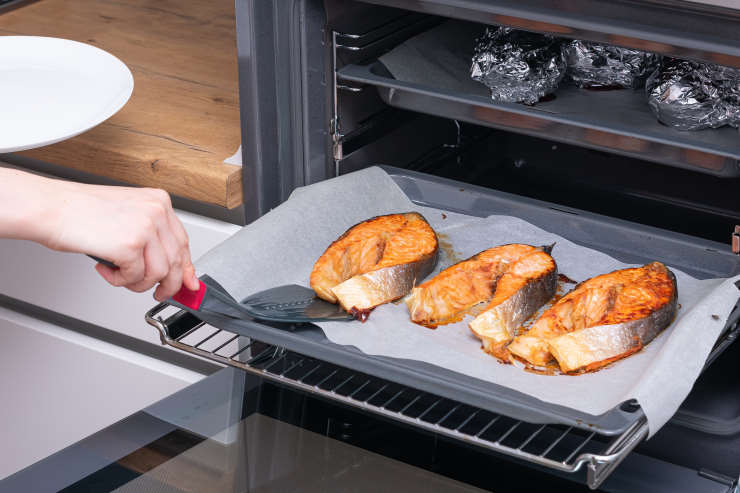
Worms, squid, crustaceans, and other fish make up this fish’s diet. As a result, many carnivores regularly consume it, including bears, seals, killer whales, sharks, otters, kingfishers, eagles, and humans. By moving resources from the nitrogen-rich ocean to inland locations, the salmon performs a crucial part in the ecosystem.
Over the course of their lifetime, salmon can have three distinct colors. Young sockeye salmon is light in color and spotted, whereas adults in the ocean are silvery blue. The adult bodies turn a blazing red, and their heads turn green when it’s ready to spawn.
The salmon lives on an annual timetable that culminates in the spawning season in the late summer or fall when they travel upstream. This schedule is dictated by instinct. Most species stay near the water; however, some Chinook or king salmon populations travel more than 2,000 miles up the Yukon River. They run and jump through the water despite the river’s flow.
How to Cook Salmon in the Oven
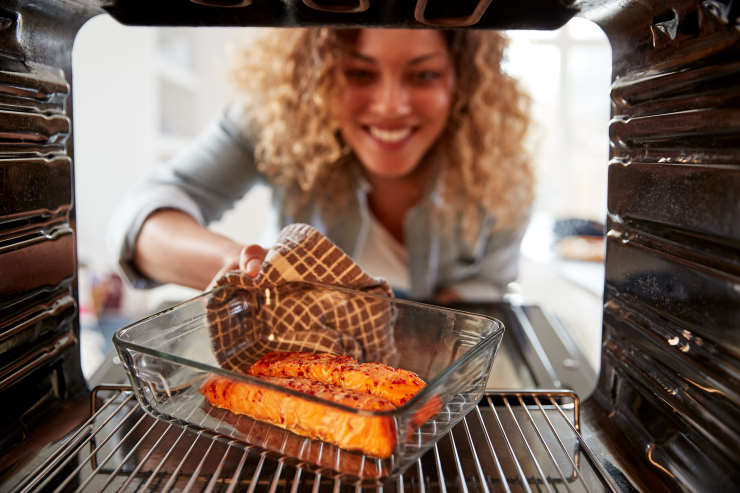
Today, we’ll demonstrate the quickest, simplest method for baking fish in the oven. It’s the kind of recipe you want to carry in your back pocket, despite the fact that it hardly qualifies as one. Once you’ve tried it, you won’t need to worry about what to do with salmon again. You can dress up this simple baked salmon recipe with stylish side dishes to serve to company or enjoy it as a nutritious, straightforward, and quick dinner on a hectic evening.
It makes a feast-like meal. We guarantee you can master this salmon dish in just one attempt. It is healthy, delicious, and adaptable. Weeknight dinners are all about this juicy, delicious, and flaky baked salmon! The ingredients for this recipe are minimal: just a few salmon filets, a fast lemon butter sauce, and herbs. Allow the oven to do its magic after that! Salmon is a fairly thin fish, so if it’s not prepared properly, it can soon dry out.
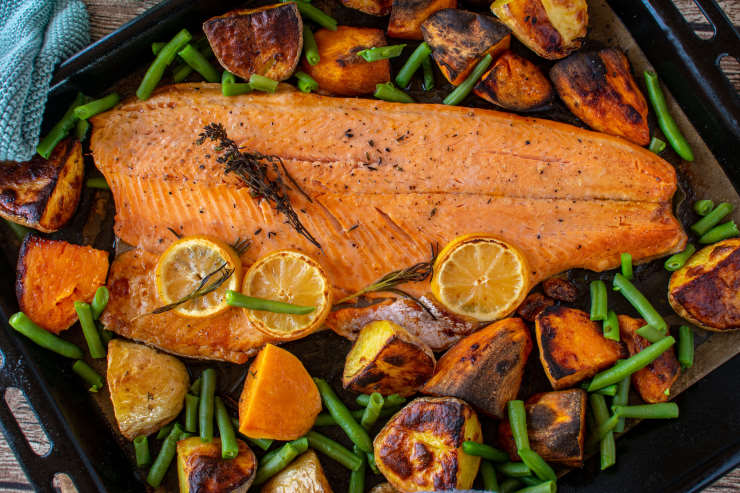
Salmon should be cooked for 10 minutes per inch of thickness as a general rule of thumb. Combine the brown sugar, salt, paprika, garlic powder, and black pepper to make a simple salmon spice rub. Foil lining a baking sheet will make cleanup much simpler.
Yes, you can bake it right on the pan, but trust us when we say that you don’t want to scrape the skin off of the salmon to do so. The culinary chore that will kill you. Place the salmon filet on the baking sheet with the skin-down and pink side up. Apply a mixture of olive oil and spices to the salmon.
Salmon filet baked! For 10-15 minutes at 375°F, observe the fish carefully to prevent overcooking. Our research shows that baking the salmon at a lower temperature of 375°F will keep it extra moist and prevent overcooking. Because let’s face it, while you’re busy preparing other meals, it’s simple to lose sight of time.
Salmon can be overcooked quite easily, and many people mistakenly believe they don’t like it simply because they’ve always done it that way or have had it served them that way, determining the salmon’s internal temperature! Your salmon filet is medium-rare if the instant-read thermometer reads 115°F to 125°F when used on the thickest area of the filet.
Is Salmon Healthy?

A frozen salmon filet can be kept in the freezer so that you can basically always create baked salmon whenever you need a quick dinner. Baked salmon is also quick, easy, and healthy. Additionally, it complements almost anything. Omega-3 fatty acids, which have been linked to improved heart health, brain function, and relief from joint discomfort, are abundant in salmon. Salmon also has a lot of vitamins and minerals and is a wonderful source of protein.
Increased eating of fatty seafood like salmon lowers the chance of developing diabetes, heart disease, and obesity. This is because it raises the body’s “good” cholesterol level. Additionally, low in calories, baked salmon is a fantastic option for people watching their weight. Therefore, baking salmon is not only a nutritious recipe, but it’s also a tasty and simple way to enjoy this healthy fish!
You can practically always make baked salmon whenever you need a quick dinner by keeping a frozen salmon filet in the freezer. Baked salmon is also quick, easy, and healthy. It also goes well with almost anything. Salmon has a lot of omega-3 fatty acids, which have been linked to better heart health, brain function, and relief from joint pain.

